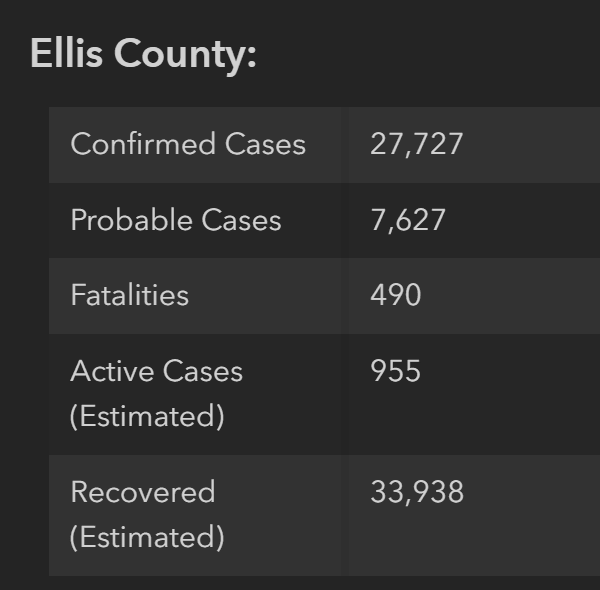955 Active COVID-19 Cases in Ellis County
While some families gathered to celebrate Christmas together others were quarantining at home, thanks to a positive COVID-19 case and the inconvenient uptick in COVID-19. Due to an increased demand in testing, it’s become difficult to find at home COVID tests in stock and lines at COVID-19 kiosks are long.
In Midlothian, the COVID-19 drive-thru kiosk at the MISD Multipurpose Stadium has extended their hours to meet demand. They are now open daily from 7 a.m. to 6 p.m. The testing kiosk is located at Midlothian ISD Multi-Purpose Stadium, 1800 S. 14th St. (enter the Stadium off of US 287 Service Road), Gate C. Appointments are currently required and can be scheduled at www.curative.com. Note: The kiosk will be closed on New Year’s Eve and New Year’s Day.
Due to the holidays there’s a delay in reporting, but according to DSHS dashboard today there are 955 active COVID-19 cases in Ellis County. Of course health officials are warning the numbers are likely much higher due to at home testing and delays at labs because of the holidays. The county reports there are 28 COVID-19 patients hospitalized, with 5 in the ICU and 23 on a MedSurg unit. Covid ActNow shows Ellis County’s positivity rate at 15.7% which is higher than Dallas (13.2%) and Tarrant County (10.8%). Data from the Texas Tribune shows Ellis County’s COVID cases have increased 123% over the last 14 days.
Across the state the positivity rate set a new record high at 22.3% according to the Texas Tribune, with nearly 1 in 4 people testing positive. Just two weeks ago the state’s positivity rate was 9.19%.
Dallas County Raises Threat Level To Red
In Dallas County the threat level has been moved to red (highest threat level) due to the sustained increase in positive cases and more. The Public Health Committee sent a letter to Judge Jenkins which said, “Our review demonstrated a dramatic increase in the number of COVID-19 cases, hospitalizations and the hospital census in Dallas in the past week,” the committee’s letter states. “We do also know that we have clusters of COVID-19 associated with social events, increased outbreaks in congregate settings and Dallas County is seeing a significant impact on the health care staffing and with pressure on emergency departments.”
It continued, “At this point data from Dallas County demonstrate 1. A sustained increase in the % positivity among symptomatic and asymptomatic tested individuals (up to 40% in some healthcare settings); 2. An increase in emergency room visits for COVID-19 like illness, with over 25% of ED visits the last few days being for suspected COVID; 3. Increasing reports of inadequate testing facilities and access to testing (and testing kits) throughout the community (it appears that the healthcare facilities do have adequate supplies); 4. Increased reports of workforce and staffing challenges in acute care and long-term care facilities; 5. An increase in the hospital census, up to 333 as of 12/27, a 50% increase in the last week. 6. Rapidly rising COVID cases, with PCCI reporting a 76.3% week over week increase to 5541 through 12/23. 7. Elevated pediatric hospitalizations for COVID.
We also know that despite the efforts of the healthcare and public health communities our vaccination rates (fully vaccinated) remain around 54% with only 13.6% of the total population boosted. With these trends assessed and a complete review of all metrics used, the Committee did move the county’s risk level to RED. Updated guidance for the public has been sent to Ms. Blum and reflects the current situation with the highly contagious Omicron variant. We are very concerned and want to emphasize the importance and need for your and the Commissioner’s leadership and help in
1. Increasing the vaccination rates in Dallas County residents. We must get our population vaccinated and boosted to provide stronger protections against severe illness and hospitalization.
2. Enhancing testing capacity and access to testing to help our residents identify cases so that the affected can isolate and prevent further transmission.
3. Reinforcing and using tools available to them to implement universal masking and physical distancing in public areas.
4. Limiting the size of public gatherings to allow for physical distancing.
5. Encouraging the use of masking, physical distancing and vaccination together to combat this current variant.
We understand that everyone is tired of the pandemic and wants to get back to normal and celebrate. New Year’s gatherings, especially those in bar or other large indoor public settings pose a substantial risk for spread in the community. We encourage everyone to celebrate at home, or in small private gatherings, utilizing pre-event testing, masking, physical distancing and ventilation strategies to reduce the risk of spread.”














